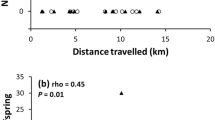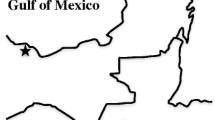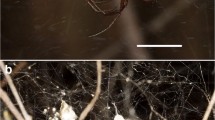Abstract
Mate search plays a central role in hypotheses for the adaptive significance of extreme female-biased sexual size dimorphism (SSD) in animals. Spiders (Araneae) are the only free-living terrestrial taxon where extreme SSD is common. The “gravity hypothesis” states that small body size in males is favoured during mate search in species where males have to climb to reach females, because body length is inversely proportional to achievable speed on vertical structures. However, locomotive performance of males may also depend on relative leg length. Here we examine selection on male body size and leg length during mate search in the highly dimorphic orb-weaving spider Argiope aurantia, using a multivariate approach to distinguish selection targeted at different components of size. Further, we investigate the scaling relationships between male size and energy reserves, and the differential loss of reserves. Adult males do not feed while roving, and a size-dependent differential energy storage capacity may thus affect male performance during mate search. Contrary to predictions, large body size was favoured in one of two populations, and this was due to selection for longer legs. Male size was not under selection in the second population, but we detected direct selection for longer third legs. Males lost energy reserves during mate search, but this was independent of male size and storage capacity scaled isometrically with size. Thus, mate search is unlikely to lead to selection for small male size, but the hypothesis that relatively longer legs in male spiders reflect a search-adapted morphology is supported.



Similar content being viewed by others
References
Abouheif E, Fairbairn DJ (1997) A comparative analysis of allometry for sexual size dimorphism: assessing Rensch’s rule. Am Nat 149:540–562
Amaya CC, Klawinski PD, Formanowicz DR (2001) The effects of leg autotomy on running speed and foraging ability in two species of wolf spider, (Lycosidae). Am Midl Nat 145:201–205
Anderson JF (1970) Metabolic rates of spiders. Comp Biochem Physiol 33:51–72
Andersson M (1994) Sexual selection. Princeton University Press, Princeton
Andrade MCB (2003) Risky mate search and male self-sacrifice in redback spiders. Behav Ecol 14:531–538
Blanckenhorn WU (2000) The evolution of body size: what keeps organisms small? Q Rev Biol 75:385–407
Blanckenhorn WU, Preziosi RF, Fairbairn DJ (1995) Time and energy constraints and the evolution of sexual size dimorphism - to eat or to mate? Evol Ecol 9:369–381
Blanckenhorn WU, Morf C, Mühlhäuser C, Reusch T (1999) Spatiotemporal variation in selection on body size in the dung fly Sepsis cynipsea. J Evol Biol 12:563–576
Blanckenhorn WU, Kraushaar U, Reim C (2003) Sexual selection on morphological and physiological traits and fluctuating asymmetry in the yellow dung fly. J Evol Biol 16:903–913
Bridge AP, Elwood RW, Dick JTA (2000) Imperfect assessment and limited information preclude optimal strategies in male-male fights in the orb-weaving spider Metellina mengei. Proc R Soc London Biol Sci 267:273–279
Brodie EDI, Moore AJ, Janzen FJ (1995) Visualizing and quantifying natural selection. Trends Ecol Evol 10:313–318
Calder WA (1984) Size, function, and life history. Harvard University Press, Cambridge
Christenson TE (1990) Natural selection and reproduction: a study of the golden orb-weaving spider. In: Dewsbury DA (ed) Contemporary issues in comparative psychology. Sinauer, Sunderland, Mass.
Coddington JA, Hormiga G, Scharff N (1997) Giant female or dwarf male spiders? Nature 385:687–688
Darwin C (1871) Sexual selection and the descent of man. Murray, London
Elgar MA, Ghaffar N, Read AF (1990) Sexual dimorphism in leg length among orb-weaving spiders: a possible role for sexual cannibalism. J Zool 222:455–470
Enders F (1974) Vertical stratification in orb-web spiders (Araneidae, Araneae) and a consideration of other methods of coexistence. Ecology 55:317–328
Fairbairn DJ (1997) Allometry for sexual size dimorphism: pattern and process in the coevolution of body size in males and females. Annu Rev Ecol Syst 28:659–687
Fairbairn DJ, Preziosi RF (1996) Sexual selection and the evolution of sexual dimorphism in the water strider, Aqurius remigis. Evolution 50:1549–1559
Fairbairn DJ, Reeve JP (2001) Natural selection. In: Fox CW, Roff DA, Fairbairn DJ (eds) Evolutionary ecology. Concepts and case studies. Oxford University Press, Oxford, pp 35–54
Ferguson IM, Fairbairn DJ (2000) Sex-specific selection and sexual size dimorphism in the water strider Aquarius remigis. J Evol Biol 13:160–170
Foelix RF (1996) Biology of spiders. Oxford University Press, New York
Foellmer MW (2004) Sexual dimorphism and sexual selection in the highly dimorphic orb-weaving spider Argiope aurantia (Lucas). PhD Thesis, Concordia University, Montreal
Foellmer MW, Fairbairn DJ (2003) Spontaneous male death during copulation in an orb-weaving spider. Proc R Soc London Biol Sci 270(Suppl):183–185
Foellmer MW, Fairbairn DJ (2004) Males under attack: sexual cannibalism and its consequences for male morphology and behaviour in an orb-weaving spider. Evol Ecol Res 6:1–19
Gerhardt U (1924) Neue Studien zur Sexualbiologie und zur Bedeutung des sexuellen Größendimorphismus der Spinnen. Z Morph Ökol Tiere 1:507–538
Ghiselin MT (1974) The economy of nature and the evolution of sex. University of California Press, Berkeley
Greenstone MH, Bennet AF (1980) Foraging strategy and metabolic rate in spiders. Ecology 61:1255–1259
Head G (1995) Selection on fecundity and variation in the degree of sexual size dimorphism among spider species (class Araneae). Evolution 49:776–781
Higgins L (2002) Female gigantism in a New Guinea population of the spider Nephila maculata. Oikos 99:377–385
Hormiga G, Scharff N, Coddington JA (2000) The phylogenetic basis of sexual size dimorphism in orb-weaving spiders (Araneae, Orbiculariae). Syst Biol 49:435–462
Jann P, Blanckenhorn WU, Ward PI (2000) Temporal and microspatial variation in the intensities of natural and sexual selection in the yellow dung fly Scathophaga stercoraria. J Evol Biol 13:927–938
Kleinbaum DG, Kupper LL, Muller KE, Nizam A (1998) Applied regression analysis and other multivariable methods. Duxbury, Pacific Grove
Kotiaho JS (1998) Sexual differences in metabolic rates of spiders. J Arachnol 26:401–404
Kotiaho J, Alatalo RV, Mappes J, Parri S, Rivero A (1998a) Male mating success and risk of predation in a wolf spider: a balance between sexual and natural selection? J Anim Ecol 67:287–291
Kotiaho J, Alatalo RV, Mappes J, Nielsen MG, Parri S, Rivero A (1998b) Energetic costs of size and sexual signalling in a wolf spider. Proc R Soc London Biol Sci 265:2203–2209
Kotiaho J, Alatalo RV, Mappes J, Parri S (1999) Sexual signalling and viability in a wolf spider (Hygrolycosa rubofasciata): measurements under laboratory and field conditions. Behav Ecol Sociobiol 46:123–128
Lande R (1980) Sexual dimorphism, sexual selection, and adaptation in phylogenic characters. Evolution 34:292–305
Lande R, Arnold SJ (1983) The measurement of selection on correlated characters. Evolution 37:1210–1226
LeGrand RS, Morse DH (2000) Factors driving extreme sexual size dimorphism of a sit-and-wait predator under low density. Biol J Linn Soc 71:643–664
Levi HW (1968) The spider genera Gea and Argiope in America (Araneae: Araneidae). Bull Mus Comp Zool 136:319–352
Marshall SD, Gittleman JL (1994) Clutch size in spiders: is more better? Funct Ecol 8:118–124
McCook HC (1890) American spiders and their spinning work, vol II. The Wistar Institute of Anatomy and Biology, Philadelphia
Moya-Laraño J, Halaj J, Wise DH (2002) Climbing to reach females: Romeo should be small. Evolution 56:420–425
Prenter J, Montgomery WI, Elwood RW (1995) Multivariate morphometrics and sexual dimorphism in the orb-web spider Metellina segmentata (Clerk, 1757) (Araneae, Metidae). Biol J Linn Soc 55:345–354
Prenter J, Montgomery WI, Elwood RW (1997) Sexual dimorphism in northern temperate spiders: implications for the differential mortality model. J Zool 243:341–349
Prenter J, Elwood RW, Montgomery WI (1998) No association between sexual size dimorphism and life histories in spiders. Proc R Soc London Biol Sci 265:57–62
Prenter J, Elwood RW, Montgomery WI (1999) Sexual size dimorphism and reproductive investment by female spiders: a comparative analysis. Evolution 53:1987–1994
Reeve JP, Fairbairn DJ (2001) Predicting the evolution of sexual size dimorphism. J Evol Biol 14:244–254
Reiss MJ (1989) The allometry of growth and reproduction. Cambridge University Press, Cambridge
Robinson MH, Robinson B (1980) Comparative studies of the courtship and mating behavior of tropical araneid spiders. Pac Insects Monogr 36:1–218
Roff D (2002) Life history evolution. Sinauer Associates, Sunderland
Schneider JM, Herberstein ME, de Crespigny FE, Ramamurthy S, Elgar MA (2000) Sperm competition and small size advantage for males of the golden orb-web spider Nephila edulis. J Evol Biol 13:939–946
Tolbert WW (1976) Population dynamics of the orb-weaving spiders Argiope trifasciata and A. aurantia (Araneae: Araneidae): density changes associated with mortality, natality, and migration. PhD Thesis, University of Tennessee
Vollrath F (1980) Male body size and fitness in the web-building spider Nephila clavipes. Z Tierpsychol 53:61–78
Vollrath F (1998) Dwarf males. Trends Ecol Evol 13:159–163
Vollrath F, Parker GA (1992) Sexual dimorphism and distorted sex ratios in spiders. Nature 360:156–159
Walker SE, Rypstra AL (2003) Sexual dimorphism and the differential mortality model: is behaviour related to survival? Biol J Linn Soc 78:97–103
Watson PJ, Lighton JRB (1994) Sexual selection and the energetics of copulatory courtship in the Sierra dome spider, Linyphia litigiosa. Anim Behav 48:615–626
West GB, Brown JH, Enquist BJ (2000) The origin of universal scaling laws in biology. In: Brown JH, West GB (eds) Scaling in biology. Oxford University Press, New York, pp 87–112
Wise DH (1993) Spiders in ecological webs. Cambridge University Press, New York
Acknowledgements
We thank James Grant, Grant Brown, Paul Albert, Wolf Blanckenhorn and one anonymous reviewer for helpful comments on the manuscript. Jamie Dubois, Catherine Pollock and Genevieve Ring assisted the field work. We are grateful to the family Minder for letting us work on their property on Île Perrot. This study was supported by grants to D.J.F. from the Natural Sciences and Engineering Research Council of Canada and a doctoral scholarship to M.W.F. from the Fonds pour la Formation de Chercheurs et l’Aide à la Recherche de Québec.
Author information
Authors and Affiliations
Corresponding author
Rights and permissions
About this article
Cite this article
Foellmer, M.W., Fairbairn, D.J. Selection on male size, leg length and condition during mate search in a sexually highly dimorphic orb-weaving spider. Oecologia 142, 653–662 (2005). https://doi.org/10.1007/s00442-004-1756-3
Received:
Accepted:
Published:
Issue Date:
DOI: https://doi.org/10.1007/s00442-004-1756-3




